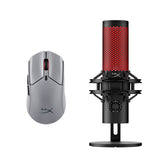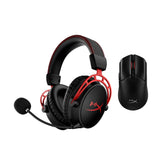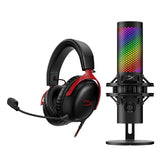The Difference Between Wired, Wireless, and Bluetooth Headsets
Technology is constantly moving forward, and with that technology comes advancement in the area that we care most about: Gaming gear. However, just because tech is new doesn’t automatically make it right for you. It’s not always a given that newer technologies are superior in every way to the older ones. Take the evolution of keyboards, for example. We have touchscreen keyboards now, but few, if any, would want to replace the tactile feedback of mechanical or membrane keypresses with touch-typing on cold glass for their daily work.
Headsets are another obvious area where new technologies are being pushed and slightly older technologies are maturing. So which type should you add to your arsenal? In this article, we’re going to focus on the choice between wired, wireless, and Bluetooth headsets. We’ll detail the differences and maybe we can get you closer to figuring out which one might be best for you.
Wired headsets
Wired headsets are the tried and true. There’s an old engineering adage that something isn’t finished when there is nothing left to add, but rather, when there is nothing left to take away. Sometimes, keeping things simple means that you gain reliability and ease-of-use. The ability to plug directly into the 3.5mm jack or the USB connector on whatever device you’re gaming on to immediately get great audio clarity is a big benefit.
A wired headset like the HyperX Cloud III (compatible with PC, Mac, PS5, PS4, Xbox Series X/S, Xbox One, and Switch) is a perfect option for someone who is just looking to plug in and drop in. The flexible, metal frame is durable enough to handle travel, twists, and accidents, and the plush memory foam in the headband and ear cups will ensure you're kept in comfort wherever you choose to play.
Another area where wired headsets typically shine in comparison to wireless headsets is in their frequency response range. In order to ensure that the wireless transmission of data is as fast as possible to reduce audio lag, sometimes the audio is compressed, and sometimes frequencies at the extreme high and low end of the scale can be squeezed out. Wired headsets typically can output a wider range of bass and treble.
The Cloud Alpha S can pump out sound at frequencies from 13Hz–27 kHz, and the Cloud Flight will hit you with 15Hz–23kHz when wired, but that range drops to 20Hz–20 kHz over 2.4 GHz wireless. For most people, any of those frequency ranges are still going to sound great, but if you’re the type of audiophile who’s able to hear a dropped pin and know exactly what metal it was made of, you’re likely going to want to indulge your highly developed senses with a fully wired experience.
The biggest downside to the wired headset...is the wire. You’re tethered to whatever device you’re using. Being able to plug into wireless controllers or a mobile gaming device certainly makes things a little less claustrophobic and less potentially catastrophic. For some people the trade-off of never tripping over their headset cable is worth some of the drawbacks that wireless options provide.
Wireless headsets
Most of the popular wireless gaming headsets on the market today transmit audio information over RF (radio frequency) using the 2.4 GHz frequency band. This frequency band is preferred for gaming because it offers pretty fast data transmission speeds, solid transmission range, and the 2.4 GHz band also provides a robust connection because that frequency band is low enough to penetrate solid objects.
The main benefit that the HyperX Cloud III Wireless and other 2.4 GHz wireless headsets offer you is freedom. That release from physical connection allows you to go downstairs to grab something to drink and get some squats in while still discussing strats and picks in the Overwatch 2 lobby. Maybe your cat needs to be fed, but you also want to make sure you’re not so caught up in adorable feline distractions that you end up dropping badly in Apex or Fortnite.

There is a slight delay in transmission time, as radio waves traveling through the air lose the footrace to electrical pulses taking the cable express, but the latency in most 2.4 GHz headset delivers something pretty damn close to wired transmission speeds with only a tiny reduction in frequency response. And if you’re playing on PC? A lifetime activation for DTS Headphone: X Spatial Audio – included with the Cloud III Wireless and wired editions – will already be bolstering your immersion.Your immersion will already be bolstered by a lifetime activation for DTS Headphone: X Spatial Audio when you pick up the Cloud III Wireless.
While this wireless technology is robust and reliable, it does also require the use of a transceiver. The Cloud III, for example, uses a USB transceiver, which limits its wireless compatibility to any device that supports a USB wireless audio dongle. If you’re a PC, PS5, or Xbox Series X|S player, you’re golden. If you want to use your Cloud III on anything else, like, say a Nintendo Switch or Xbox One, you’re going to have to plug the included 3.5mm audio cable into a standard headphone jack.
The final drawback with any wireless headset should be obvious...batteries. Gotta have some way to get power to the headset, and if it’s not through a cable, well, it’s gotta be bundled in. Thankfully, the Cloud III Wireless gets up to 120-hours of battery life*. That’s a gargantuan two straight weeks of eight-hour play sessions each and every day! If you just remember to plug it in at the end of one of them, you won’t come close to running out of charge.
So, if you’re a gamer that prioritizes freedom, hates the clutter of cables, or likes to roam around a bit during their game time, perhaps a wireless headset is right for you.
Bluetooth headsets
The last category we’re going to look at today is Bluetooth headsets, an offshoot of wireless headsets with its own unique set of advantages and disadvantages. There are still no wires, you still have freedom, but the broadcast range for Bluetooth isn’t quite as far as you’d get with 2.4 GHz wireless. This can be perfectly fine if you just want to listen to your phone in your pocket on the way to work, or won’t stray too far from your audio source. The main benefit of Bluetooth is that Bluetooth devices all work together, without the need for a dongle. Once you’re paired, you’re good to go with anything that is Bluetooth compatible, no worrying about losing a dongle or being bound by a cable.
Now, for the downsides. With advances in audio codecs and APIs, wireless transmission latency has dropped, but Bluetooth is still a step behind 2.4 GHz wireless. That little bit of extra latency might make gaming over Bluetooth a disorienting experience. The versatile HyperX Cloud MIX deals with this by including a cable you can connect while you want to game with Hi-Res audio clarity, and when you want to listen to music or go out on the town, you can detach the cable and mic and get wireless Bluetooth connectivity. It’s wired for gaming, and Bluetooth for your busy life. At 260g with everything detached, the Cloud MIX is the perfect game and go headset.
The other major downside with a Bluetooth headset is also one of its upsides. Bluetooth devices easily connect to one another wirelessly, but without additional workarounds they ONLY connect to one another. So while any modern variant of Android or iPhone will connect, along with your modern tablet or laptop, Nintendo Switch, smart speaker, or home assistant, you’re going to have problems connecting to some consoles without additional equipment.
That wraps up our comparison of the different use cases of wired vs. 2.4 GHz wireless vs. Bluetooth wireless headsets. Hopefully this answers some of the bigger questions you had on the topic, and you feel more confident in finding the headset that fits your needs best.
*Tested at 50% headphone volume. Battery life varies based on volume and usage.
___
About HyperX
For 19 years, HyperX’s mission has been to develop gaming solutions for every type of gamer and the company is consistently recognized for delivering products that provide superior comfort, aesthetics, performance, and reliability. Under the tagline of “WE’RE ALL GAMERS,” HyperX gaming headsets, keyboards, mice, USB microphones, and console accessories are the choice of everyday gamers as well as celebrity ambassadors, pro gamers, tech enthusiasts, and overclockers worldwide because they meet the most stringent product specifications and are built with best-in-class components. For more information, please go to www.hyperx.com.
About HP
HP Inc. creates technology that makes life better for everyone, everywhere. Through our product and service portfolio of personal systems, printers, and 3D printing solutions, we engineer experiences that amaze. More information about HP Inc. is available at https://www.hp.com.
# # #
HyperX and the HyperX logo are registered trademarks or trademarks of HP Inc.in the U.S. and/or other countries. All registered trademarks and trademarks are property of their respective owners.






